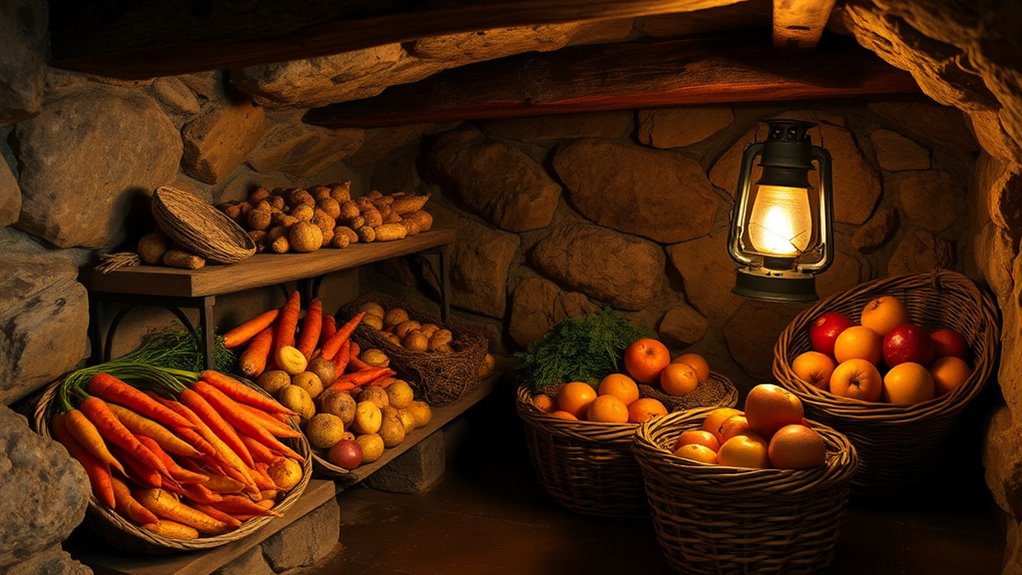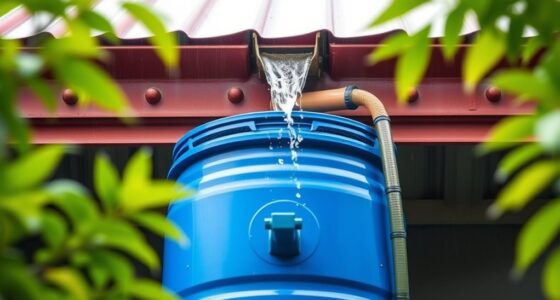To build and use a root cellar, first choose a cool, shaded location with stable temps and high humidity, ideally underground or on a hillside. Plan your space with insulation, proper ventilation, and shelving to keep produce fresh. Use durable materials like concrete or treated wood. Build your cellar following safety steps, ensuring good airflow and insulation. Organize your harvest efficiently to extend freshness. Exploring these tips further helps you create an effective storage solution.
Key Takeaways
- Choose a shaded, naturally insulated site with stable, cool temperatures and high humidity for optimal storage conditions.
- Construct the cellar using durable materials like concrete blocks or treated wood, with proper insulation and moisture barriers.
- Incorporate passive or adjustable vents to promote natural airflow, maintaining consistent temperature and humidity levels.
- Organize stored crops by type and ripeness in breathable containers, labeling for easy inventory management.
- Regularly inspect and clean the cellar to prevent spoilage, removing any spoiled produce and maintaining proper ventilation.
Choosing the Ideal Location for Your Root Cellar

Selecting the right location for your root cellar is crucial to guarantee your stored harvest stays fresh and safe. You want a spot with consistent, cool temperatures, ideally between 32°F and 40°F, and high humidity. Choose a shaded area to prevent temperature fluctuations caused by sunlight. A naturally insulated site, like a hillside or under a slope, helps maintain a stable environment. Avoid places prone to flooding, standing water, or excessive moisture, as these can damage stored produce. Accessibility is also key—pick a location close to your home or garden for easy access during harvest. Ensure the site has good drainage and minimal exposure to pests or animals. Additionally, considering digital literacy programs can help you better understand and manage your storage environment effectively. By selecting the right spot, you’ll set the foundation for a successful, long-lasting storage solution.
Planning and Designing Your Root Cellar

Before you start building your root cellar, it’s vital to plan and design it carefully to guarantee ideal storage conditions. You need to take into account size, layout, and ventilation to keep produce fresh. Visualize your space like this:
| Storage Area | Access & Lighting | Climate Control |
|---|---|---|
| Shelves for root vegetables | Wide doorway for easy entry | Insulation to regulate temperature |
| Cool, dark corners | Minimal light exposure | Proper airflow for humidity control |
| Separate sections for different crops | Clear pathways | Ventilation vents for air circulation |
This design ensures your harvest stays in optimal condition. Map out your needs, and create a space that’s functional, accessible, and suited to your harvest size. Proper planning makes all the difference. Additionally, considering insulation techniques can significantly improve the climate regulation within your cellar.
Materials and Tools Needed for Construction

To construct a functional root cellar, you’ll need a variety of materials and tools to guarantee durability and proper construction. Start with sturdy building supplies like concrete blocks, bricks, or treated wood for the walls and foundation. Insulation materials such as foam boards or straw help maintain stable temperatures. You’ll also need a moisture barrier, like plastic sheeting, to control humidity. For tools, gather a shovel, sledgehammer, level, tape measure, and a saw to handle cutting and fitting materials. A drill, screws, and nails are essential for assembly, while a trowel helps with sealing joints. Don’t forget safety gear like gloves and goggles. Having these materials and tools ready ensures your root cellar is well-constructed, weather-resistant, and capable of preserving your harvest effectively. Proper insulation is key to maintaining the ideal temperature and humidity levels inside your root cellar.
Step-by-Step Guide to Building Your Root Cellar
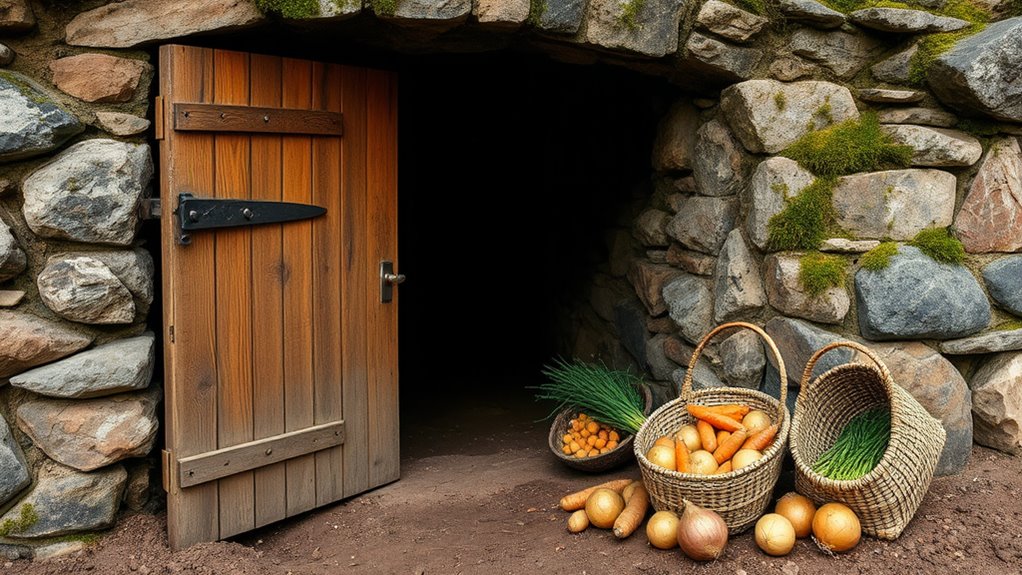
Building your root cellar begins with choosing a suitable location that offers natural protection from the elements and maintains consistent temperatures. Look for a spot with good drainage, ideally on a slope or slightly elevated ground. Avoid areas prone to flooding or excessive moisture. Clear the area of debris, rocks, and vegetation. Mark the dimensions based on your storage needs, and plan for access, such as a door or hatch. Dig a trench or pit according to your design, ensuring the walls are stable. If you’re building underground, excavate to the appropriate depth, leaving space for insulation and ventilation later. Keep the structure simple but sturdy, focusing on durability and easy access. Proper site selection sets the foundation for a successful, long-lasting root cellar. Proper site selection is essential for maintaining consistent temperatures and preventing spoilage.
Ensuring Proper Insulation and Ventilation
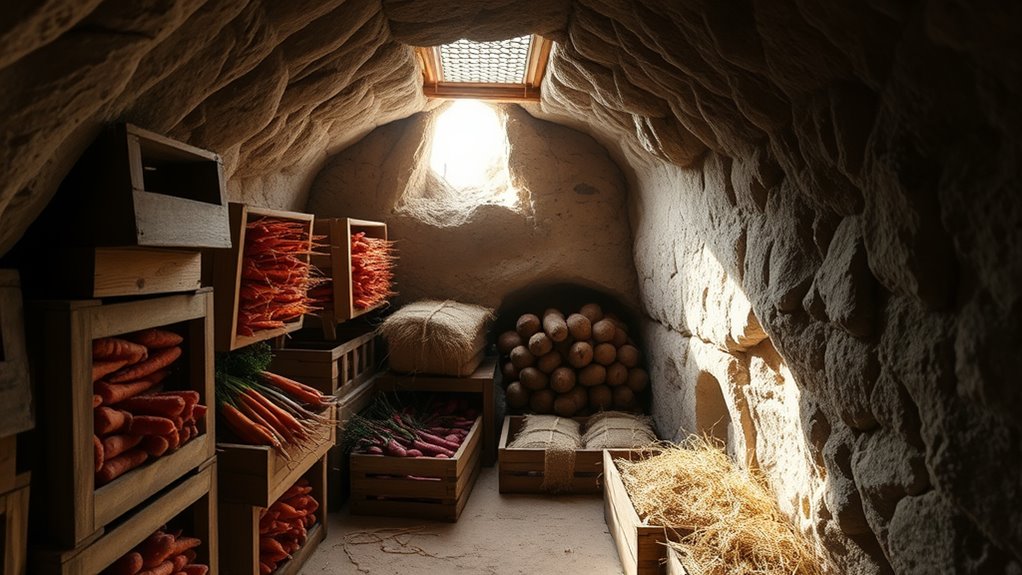
Proper insulation and ventilation are essential for maintaining the ideal temperature and humidity levels inside your root cellar. Insulation keeps heat transfer minimal, preventing temperature fluctuations that can spoil stored produce. Ventilation ensures fresh air circulates, reducing excess humidity and preventing mold. You should install insulated walls and a vent system that allows air exchange without letting in too much cold or moisture. Additionally, understanding whole-house water filtration systems can provide insights into maintaining optimal environmental conditions for your cellar. Here’s a quick overview:
| Insulation Material | Ventilation Method |
|---|---|
| Rigid foam boards | Passive vents |
| Spray foam | Exhaust fans |
| Insulated panels | Adjustable vents |
| Mineral wool | Windows with dampers |
| Straw or hay | Continuous airflow |
Proper balance between insulation and ventilation keeps your harvest fresh longer.
Maintaining the Optimal Storage Environment

To keep your root cellar ideal for storage, you need to manage temperature and humidity carefully. You can do this by adjusting ventilation and using simple methods to control moisture levels. Proper strategies will help preserve your harvest and prevent spoilage. Embracing creative practice and experimenting with different techniques can also lead to more effective storage solutions.
Temperature Regulation Techniques
Maintaining a stable temperature in your root cellar is essential for preserving your harvest effectively. Fluctuations can cause spoilage or premature sprouting. To regulate temperature, consider insulation, ventilation, and shading. Insulate walls to slow heat transfer, and use vents to allow air circulation, balancing temperature and preventing excess heat buildup. Shade the entrance and windows from direct sunlight. Use a thermometer to monitor conditions regularly. Keep the temperature around 32-40°F (0-4°C) for most root vegetables. Here’s a quick overview:
| Technique | Key Action | Benefits |
|---|---|---|
| Insulation | Add foam or straw around walls | Maintains consistent temperature |
| Ventilation | Install adjustable vents | Prevents heat buildup |
| Shading | Use curtains or overhangs | Reduces heat gain |
| Thermometer | Regularly check storage temp | Ensures proper conditions |
| Temperature Control Devices | Use thermostats or fans | Automated regulation |
Additionally, incorporating climate control devices such as fans or thermostats can help maintain a more consistent environment, especially in fluctuating weather conditions.
Humidity Control Methods
Controlling humidity levels is essential for preventing spoilage and ensuring your root vegetables stay fresh longer. Aim to maintain humidity between 85% and 95%, which slows dehydration and inhibits mold growth. To achieve this, use natural methods like placing a damp cloth or sponge inside the cellar, which adds moisture as needed. You can also install a simple humidifier or use a tray of water near the stored produce. Avoid overly dry conditions, which cause roots to shrivel, or excessive dampness, which encourages rot. Regularly check moisture levels with a hygrometer and adjust as necessary. Proper humidity keeps vegetables crisp and prevents sprouting, extending their storage life without the need for refrigeration. Security vulnerabilities in new technologies can expose businesses to fraud if not properly addressed.
Ventilation Optimization Strategies
Good airflow is key to keeping your root cellar environment stable, so your vegetables stay fresh longer. To optimize ventilation, ensure you have proper intake and exhaust vents positioned to promote continuous air circulation. Use adjustable vents or dampers to control airflow based on temperature and humidity levels. Install passive vents at different heights to facilitate natural convection, allowing cool, moist air to enter while warm, stale air exits. Regularly check and clean vents to prevent blockages that can disrupt airflow. Consider adding a small fan if natural ventilation isn’t sufficient, especially during temperature fluctuations. Proper ventilation prevents excess moisture buildup, reduces mold risk, and maintains a consistent environment, keeping your stored harvest in prime condition for longer periods. Effective ventilation also relies on understanding the principles of natural convection, which utilizes temperature and density differences to move air without mechanical aids.]
Organizing and Stockpiling Your Harvest
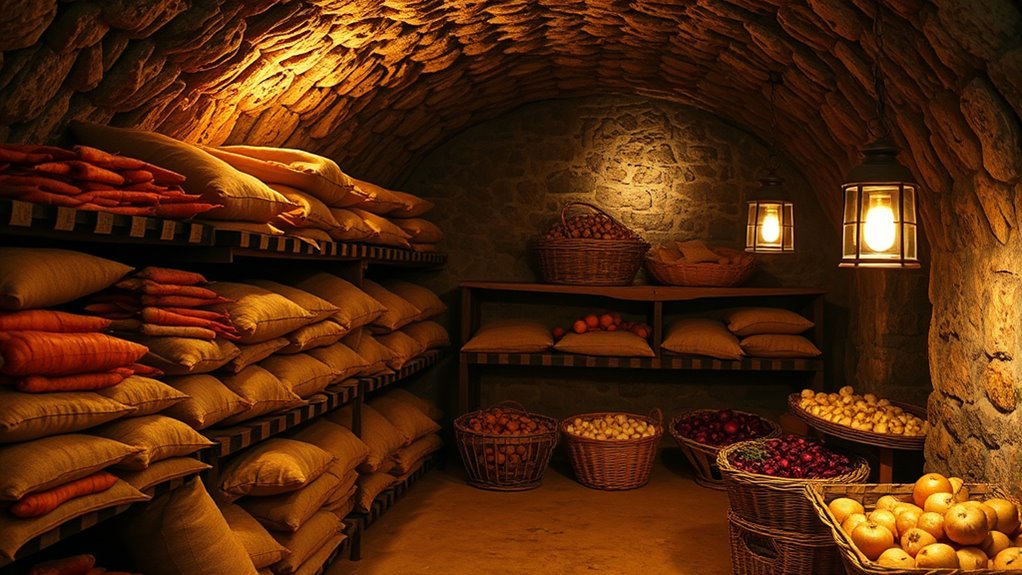
Organizing and stockpiling your harvest effectively guarantees your produce stays fresh and lasts throughout the season. Start by sorting your vegetables by type and ripeness, so you can prioritize what to use first. Use sturdy crates, bins, or shelving to keep items off the cold, damp floor and allow airflow around your produce. Label everything clearly with harvest dates to rotate stock efficiently. Store similar items together to prevent spoilage and make access easier. Keep delicate items separate from hardier ones to avoid damage. Regularly check your stored harvest for signs of spoilage or rot, removing affected produce immediately. Proper organization minimizes waste, maximizes space, and ensures you enjoy your harvest at its best for as long as possible. Incorporating proper ventilation considerations helps regulate humidity and temperature, preserving your harvest even more effectively.
Tips for Long-Term Storage and Preservation

Once you’ve sorted and stored your harvest properly, the next step is to focus on long-term preservation methods that keep your produce fresh well beyond the initial harvest. Choose the right storage conditions for each crop—cool, dark, and humid environments work best. Use breathable containers like crates or burlap sacks to prevent moisture buildup and mold. Regularly check stored items for signs of spoilage, and remove any compromised produce immediately. Consider preserving surplus by canning, freezing, or drying, which extends shelf life and preserves nutrients. Maintain consistent temperatures and humidity levels in your cellar to prevent spoilage. Proper ventilation also helps reduce mold and rot. With these tips, your harvest stays fresh and edible for months, maximizing your homegrown bounty.
Frequently Asked Questions
How Deep Should a Root Cellar Be Below Ground Level?
You should build your root cellar about 8 to 10 feet below ground level for ideal temperature stability. Digging to this depth helps maintain a consistent, cool environment ideal for storing harvests. Make sure the opening is secure and insulated to prevent temperature fluctuations. Proper ventilation is also essential. Staying within this range balances insulation and accessibility, ensuring your stored produce stays fresh throughout the season.
What Are the Best Natural Materials for Insulation?
Did you know natural materials like straw and sawdust can reduce heat transfer by up to 80%? You should use straw, hay, or wood shavings for insulation because they’re affordable, sustainable, and effective. These materials trap air, providing excellent thermal resistance. You’ll want to layer them around your cellar walls and ceiling, ensuring your stored produce stays cool and fresh naturally, saving energy and maintaining quality longer.
How Do I Prevent Pests and Rodents From Entering?
You prevent pests and rodents from entering your root cellar by sealing all entry points with durable materials like metal mesh or hardware cloth. Keep the door and vents well-sealed with weatherstripping, and guarantee no gaps exist around pipes or cracks. Regularly inspect for holes or signs of pests, and set traps or deterrents if needed. Maintaining cleanliness and removing food scraps also discourages unwanted visitors.
What Temperature Fluctuations Are Acceptable for Storage?
You should keep your root cellar’s temperature stable between 32°F and 40°F (0°C to 4°C). Fluctuations outside this range can cause spoilage or sprouting. Aim for no more than a 5°F (3°C) variation daily. Use a thermometer to monitor regularly and consider insulating the cellar well. Proper ventilation and consistent temperature help preserve your harvest and prevent spoilage or rot.
How Often Should I Check and Rotate Stored Produce?
Think of your stored produce as delicate treasures that need tender care. You should check and rotate your harvest weekly to prevent spoilage and guarantee freshness. Regularly inspecting for mold, decay, or sprouting helps catch problems early. By staying vigilant, you maintain a steady supply of quality produce, much like tending a garden—consistent attention keeps everything thriving and prevents small issues from turning into big problems.
Conclusion
With your root cellar standing sturdy and ready, you’re now the guardian of your harvest’s silent sanctuary. Like a vault of treasures beneath the earth, it keeps your bounty fresh and vibrant through seasons’ dance. As you tend to its warmth and airflow, you nurture a lasting harmony between nature’s gifts and your care. Embrace this underground haven, where your harvest’s story continues to grow, stored safe in the quiet heartbeat of your cellar’s embrace.

